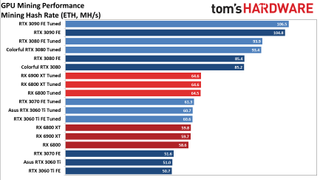You Can Mine Ethereum With Apple’s M1: Here's How, but You Probably Shouldn’t Bother
M1nor gains.

Ethereum mining is most profitable on high-end graphics cards, but enthusiasts are often willing to use whatever they have on-hand, especially as the cryptocurrency’s value continues to rise. Now they’ll have another option: Apple’s new M1 chip.
Zensors software engineer Yifan Gu found a way to make the ethminer utility run on a MacBook Air featuring the M1 processor. It required a bit of setup, but Gu made the code available on GitHub, so curious Mac owners can check it out themselves.
This isn’t the first time someone’s used the M1 for mining. CryptoAge reported in December 2020—just one month after the first Macs featuring the chip debuted—that XMRig’s developers had experimented with mining the Monero cryptocurrency.
The experiments yielded similar results. Gu said the MacBook Air could only mine Ethereum at roughly 2MH/s; CryptoAge said the M1 offered similar performance mining Monero. This would lead to profits equivalent to just $0.14 of daily profitability with either coin.
| Row 0 - Cell 0 | Ethereum Hash Rate | Rated Power |
| Apple M1 | 2 MH/s | ~17W to 20W (GPU only) |
| Nvidia 30HX | 26 MH/s | 125W |
| Nvidia 40HX | 36 MH/s | 185W |
| Nvidia 50HX | 45 MH/s | 250W |
| Nvidia 90HX | 86 MH/s | 320W |
Those figures pale in comparison to the performance offered by discrete graphics cards, especially if they’ve been optimized for mining, and even the weakest of Nvidia’s new Cryptocurrency Mining Processors boasts a hash rate of 26 MH/s.

As you can see above, the M1 doesn't hold a candle to Etherum hash rates with gaming GPUs, either. Of course, the difference boils down to power - Nvidia's graphics cards have a far higher power budget, and it's hard to tell how Apple's GPU architecture would stack up if the eight-core design were scaled to a larger device with more computational power. There are reports that Apple is working on 128-core GPUs to replace AMD's graphics cards in its systems, so we might not need to wait long to find out.
Does the low hash rate make the ability to mine Ethereum on an M1-equipped Mac less interesting? Not to someone curious about the possibilities of Apple silicon. For serious cryptocurrency miners, however, there are far better options available.
Stay on the Cutting Edge
Join the experts who read Tom's Hardware for the inside track on enthusiast PC tech news — and have for over 25 years. We'll send breaking news and in-depth reviews of CPUs, GPUs, AI, maker hardware and more straight to your inbox.

Nathaniel Mott is a freelance news and features writer for Tom's Hardware US, covering breaking news, security, and the silliest aspects of the tech industry.
-
zodiacfml wasted effort. they should have known the mining ETH is hard on memory and the M1 graphics uses system RAM/DDR4 something. Should have tried Kawpow/Ravencoin instead.Reply -
bkuhl He tested using a Macbook Air! No fan means the performance will degrade over time. The minimum he should have used for testing would have been a Mac Mini which has active cooling and would have sustained performance over any given time...Reply -
KuroNanashi I looked through the commits and this literally just looks like interface fluff to get it to recognise the M1 as an OpenCL capable device.Reply
Given relatively little is known about the architecture of the M1 GPU it's not surprising that it's only getting 2MH/s. The NVidia and AMD GPU miners have had a considerable amount of time and skill investment over the years to get the rates we see now and that's with considerably more knowhow into how the GPUs work. I'd imagine the 60GB/s or so of bandwidth is a limiting factor, and whilst I'm sure apples memory controller is fantastic, it's shared by system processes* and dwarfed by even el cheapo 128-bit GDDR5 cards, but I reckon it's capable of more though we'll likely not see it, because really why bother.
Most Popular



